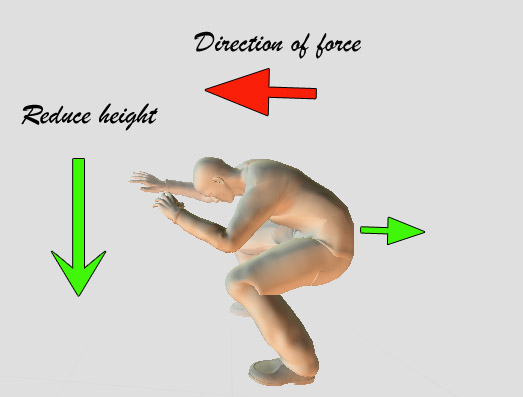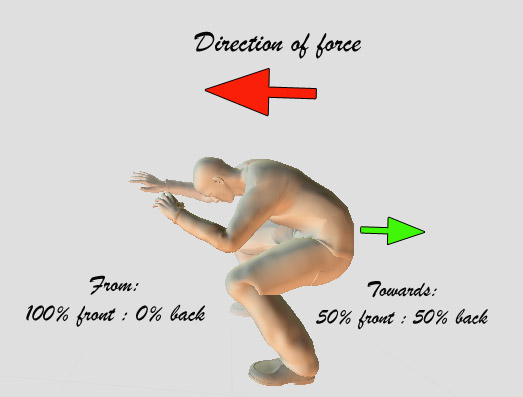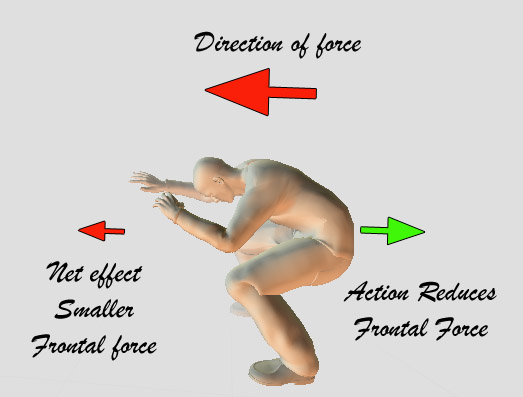As seniors, our recovery rate tends to slow down, and our bones are more fragile than they were in our younger days. Healing from a broken bone takes longer, and unfortunately, it may never feel 100% again. For some seniors, breaking a hip bone can be life-changing.
None of these can entirely prevent falling nor can it guarantee zero injuries. It simply help lessen the extent of the injuries. Remember the concept of “threshold”, this means that every person’s bone density is different but there is a threshold for each bone. If the impact is less than a certain number, then it is just a bruise. However, if it exceeds the bone’s threshold, the bone will break. All we are doing is aiming to reduce the impact below your bone’s threshold so that nothing will break.
This article is specifically about how to respond to regain balance when you feel a sudden force pushing from behind or pulling from the front, potentially causing a frontal fall. This force can be generated because of inertia, an intentional push or pull of your upper body or an imbalance. In the discussion below, this is referred to as a “force-to-front”.
Reduce the height by pushing the butt backwards
When we were kids, we didn’t have to learn how to fall. It seems so natural. When baby learn how to walk, they fell and try again countless times. What is different is that we grew a lot taller and heavier and so there are much higher chance of hurting ourselves.
Lets take another example, if you drop a crystal glass from six feet up versus dropping it at half the height, the reduced height means that the risks of it breaking is a lot less.
(The diagram below illustrates how to reduce a person’s height while attempting to rebalance themselves after a shove from behind or a pull forward.)

Reduce the weight in front by pushing your butt backwards
The force of impact is proportional to your body weight. Therefore, That is one of the reasons why kids can sustain some falls without breaking any bones.
If you eat healthy and remain active and retain a healthy body weight, you are reducing the potential impact if you do fall. So maintaining a healthy body is a nice goal over time. However, whatever your current body weight is, on a frontal fall, you can still reduce the impact by shifting your body weight backwards so that there is less weight in the front and therefore the chances of breaking your wrist or arm is lessened.
(The diagram below illustrates how moving the butt backwards help negate the “force-to-front”. The biggest mistake is to resist against the incoming force which helps amplify the attacking force. The diagram shows the net effect if you fold your upper body and manage to move your butt backwards.)

Net-out effect
If you manage to decrease/absorb part of the “force -to-front”, you not only bought yourself more time to react, you are reducing the speed of the fall. This will help reduce the force of the impact.
(The diagram helps illustrate how folding the body “takes away the surface” for the “force-to-front”, rendering it less effective. If you stand straight and stiff, therefore a perpendicular surface for the “force-to-front”, 100% of the delivered force will be delivered against your body).

Soften the landing
Our technique for landing softly involves a specific sequence: “finger-tip, fingers, palm, and a slight bend in the elbow.” The following animation attempts to illustrate this specific sequence of the hand.
Some seniors have very still fingers and/or wrists. It is very important to start stretching them so there is some “give” in the hands since that is the primary landing gear if one do fall. You do not need to be ultra flexible, all you need is some “give” just like the protective cover on your cell phone.

If you observe professional basketball players, they wear well-cushioned shoes to support their jumps and landings. They follow a specific order when landing: starting with the ball of the feet, lowering the heels, and bending at the knees and hips. Professionals never land with straight legs or flat feet.
If you happen to fall forward, your hands act as your default landing gears. Comparing this to landing with the legs, the sequence should mirror each other: “reach out with your finger-tips, land on all the fingers or the ball of the hands, land on your palm, and then bend your elbow to absorb.” This method, inspired by professional players, helps absorb most of the impact, with the remaining force mitigated by other skills.
To make landings softer, it’s crucial to avoid abrupt stops. During moments of panic, muscles tense up, and the instinct is to push out, which is counterproductive. If you freeze or push out while falling, you’re essentially fighting against the ground, and the ground will win. Softening a landing isn’t instinctive for adults, so we need to reprogram our brains through simulations. By practicing and experiencing simulated falls, we can train ourselves not to panic and learn to land in a sequence involving multiple body parts. This spreads the impact over a longer duration, reducing or avoiding its intensity.
One additional aspect to consider when softening your landing is to avoid letting any sharp parts of your body touch the ground. For instance, make sure to keep the tip of your elbow away from the surface, and be mindful of the point of your shoulder joint. It’s also advisable to be cautious about your nose and teeth making contact with the ground. By paying attention to these details, you can help ensure a less damaging landing.
Share the impact
A full-size extra-large pizza is overwhelming for a single person, but when shared among many, each person only gets a small slice. This principle extends to the concept of impact. If the force of an impact is distributed over a larger surface area, each part of the body absorbs only a fraction of the force. Conversely, if a specific body part has to endure the entire impact, it becomes too much.
Rolls are a technique that embodies this strategy of distributing impact to reduce the risk of injuries. Since it’s a more advanced technique, we’ll delve into it further in future videos and/or in-person classes.

Very interesting! I am a patient & friend of Dr Sam & Christine Siew please put me on your email list